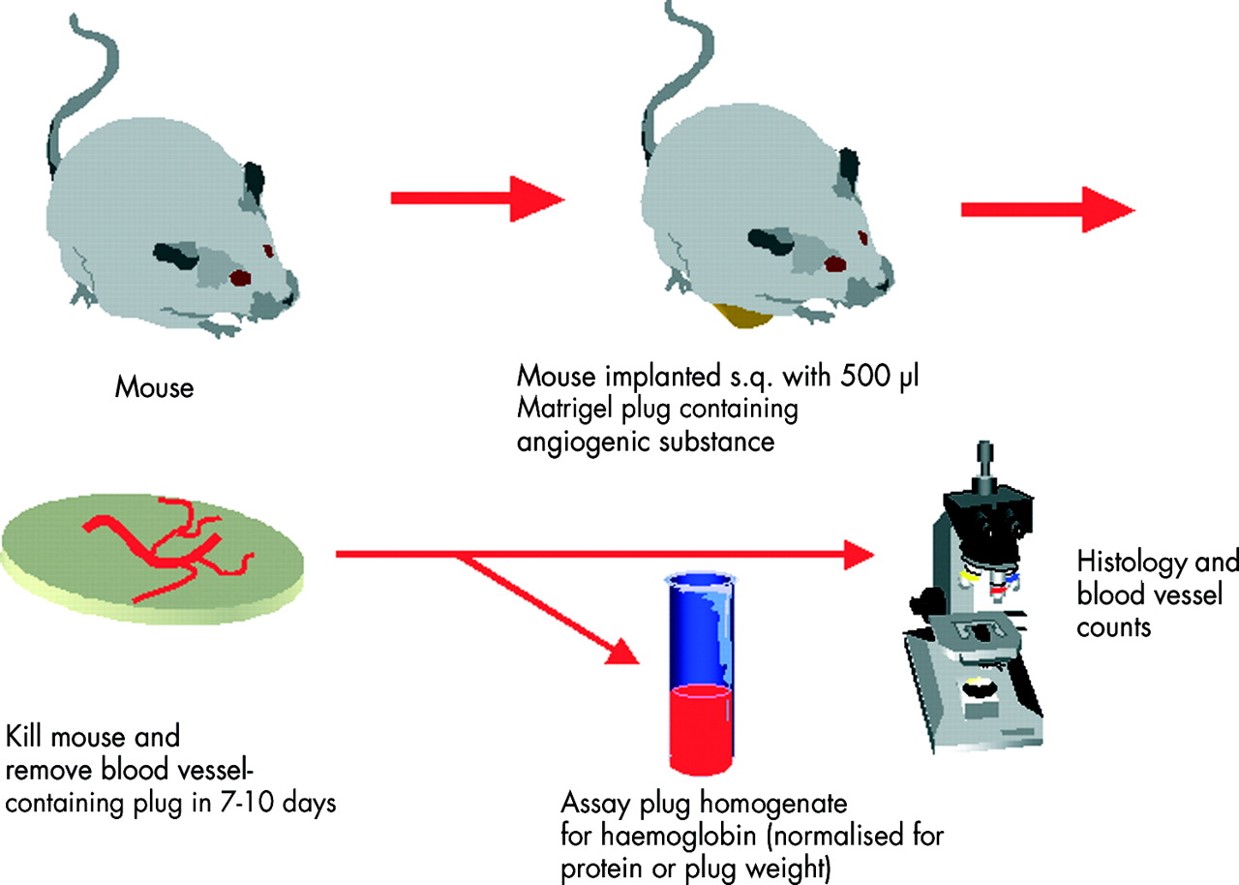Matrigel Plug Angiogenesis Assay
The subcutaneous matrigel plug assay in mice is a method of choice for the in vivo evaluation of pro- and anti-angiogenic molecules. Matrigel, a laminin-rich reconstituted matrix is an extract of the engelbreth-holm-swarm (EHS) tumor composed of basement membrane components. In the matrigel plug assay, an angiogenic stimulus (usually represented by recombinant growth factors or tumor cells) is introduced into cold liquid matrigel, following subcutaneous injection in mice, gelifies and allows the recruitment of a new microvascular network. The later immunohistochemistry (IHC) staining with the endothelial marker indicates the presence of the newly formed capillaries in the sectioned gel plugs. The procedure allows the simultaneous, quantitative evaluation of the newly-formed endothelium and of non-endothelial/inflammatory components of the cellular infiltrate in the matrigel implant, as well as the expression of genes involved in the modulation of the angiogenesis process.
One of the advantages of the in vivo matrigel assay is its ease of use without the need for surgical intervention. Since the assay can be performed in rodents, both inhibitors and activators of angiogenesis can be tested by direct inclusion of the compounds within the injected gel or by systemic delivery.
 Figure 1. Schematic diagram of the matrigel plug angiogenesis assay.
Figure 1. Schematic diagram of the matrigel plug angiogenesis assay.
Applications
- Study the basic mechanisms underlying angiogenesis at the molecular or cellular level
- Evaluate the activities of angiogenic and angiostatic compounds or cytokines in vivo
Materials and Equipment
BALB/cAnN-nu (Nude) female mouse (6-8 weeks)
Paraffin
Trypsin
Tumor cells
Centrifuges
Matrigel matrix
Anti-rat CD34
Hemocytometer
Complete medium
10% Formalin solution
Diaminobenzidine (DAB)
Hematoxylin and eosin (HE)
Phosphate buffered saline (PBS)
Streptavidin-peroxidase conjugate
Microscopic slide scanning system
Biotin-conjugated goat Anti-Rat IgG
Assay Procedure
- Remove the medium from a T175 flask containing an 80-90% confluent monolayer of tumor cells (e.g., the nasopharyngeal carcinoma HONE1 cells) and wash the cells with PBS.
- Detach the tumor cells by incubating with 3 mL trypsin for 5-10 min, stop trypsinization with 10 mL complete medium.
- Count the number of cells with a hemocytometer, spin down the cells at 1,200 rpm for 5 min and wash once with PBS.
- Mix a total of 5 x 106 to 1 x 107 cells (cell type-dependent) with 50 μL plain medium and 250 μL ice-cold matrigel (the matrigel maintains as liquid form at 2-8°C and solidifies rapidly at 22-37°C).
- Subcutaneously inject the 300 μL cell matrigel mixture into a flank of five female athymic nude mice (one injection site per mouse) with an ice-cold syringe.
- Polymerize the matrigel mixed with the cells to form a solid gel plug, which allows cell growth and blood vessel formation.
- After inoculation for 7 days, excise the matrigel, fix with formalin overnight, embed in paraffin, and section onto slides.
- Stain the slides with hematoxylin and eosin (HE) for histological observation.
- Stain the blood vessels formed with 150 μL endothelial cell marker CD34 monoclonal antibody (1:40) overnight at 4°C and 150 μL secondary biotin-conjugated goat anti-rat IgG antibody (1:100) for 1 h at room temperature (RT).
- Incubate the antibody with 150 μL streptavidin-peroxidase conjugate (1:200) at RT for 1 h.
- Add the substrate DAB for signal detection.
- Imaging and analysis, five hotspots per matrigel section and two sections per matrigel plug are analyzed at 200 X magnification.
Troubleshooting
- Solidification of matrigel before use
Matrigel is thawed slowly at 4°C overnight to prevent gelling prior to injection. If needed on the day of the assay, the frozen matrigel can be thawed until ice crystals melt by rotating the tube in the palms of the hands. It is then immediately placed on ice for the addition of cells. - Excessive bleeding
It is important to maintain a constant source and preparation lot of heparin from a single manufacturer because quality varies from lot to lot.
References
- Coltrini D, et al.; Matrigel plug assay: evaluation of the angiogenic response by reverse transcription-quantitative PCR. Angiogenesis, 2013, 16(2): 469-477.
- Lai S L, et al.; In vitro and in vivo anti-angiogenic activities of panduration A. PLoS One, 2012, 7(5): e38103.
- Yuan K, et al.; In vivo study of human endothelial-pericyte interaction using the matrix gel plug assay in mouse. J Vis Exp, 2016, 19(118): e54617.
- Koch A E. Angiogenesis as a target in rheumatoid arthritis. Annals of the Rheumatic Diseases, 2003, 62: ii60-ii67.
Cell Services:
Cell Line Testing and Assays